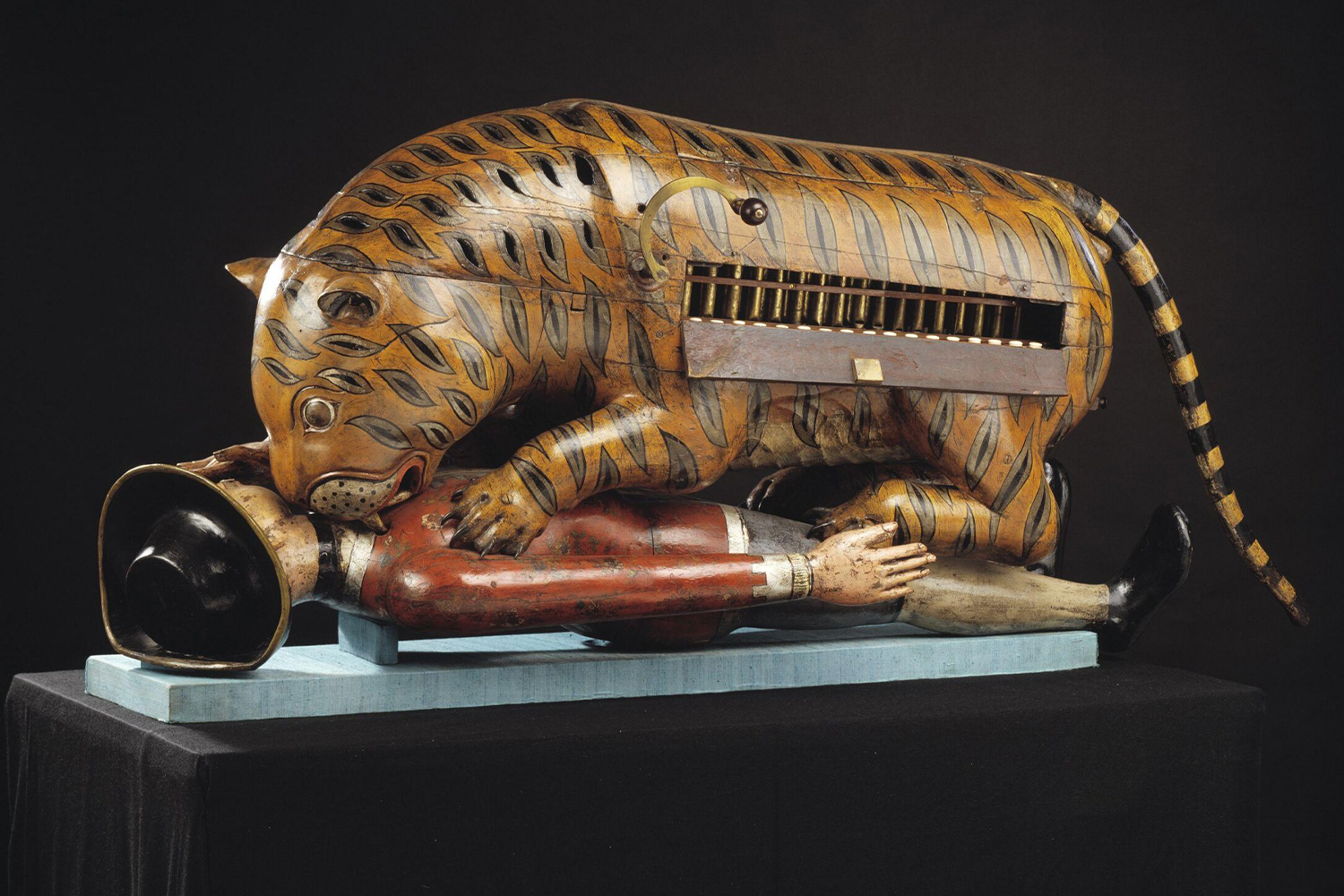ARTICLE
Tipu’s Tiger
A six-foot long musical automaton depicting a tiger mauling an English soldier, Tipu’s Tiger is carved of Indian jackwood and was made around 1794–99, likely under specific instructions from Tipu Sultan.
The soldier is wearing a red coat and broad-brimmed black hat, which point to him being an eighteenth-century English soldier. The tiger is painted in stylised stripes and has a hinged flap on its left which, when opened, reveals a set of eighteen keys and musical pipes that can be operated with a handle on the same side. When the handle is cranked, the soldier raises his left arm and makes a wailing noise even as the tiger makes a roaring sound. The automaton also plays several other tunes, including Rule Britannia and God Save the King. It was made by indigenous craftsmen and overseen by a French technician.
The tiger was looted from Tipu’s Rangmahal by the British East India Company when they seized his capital at Srirangapatna during the fourth Anglo-Mysore War (1798–99). It was then sent to England, where it was displayed in the India Museum of the East India House from 1808 onwards. Initially, visitors to the museum could crank the handle of the automaton and hear the noises and tunes, until the mechanism became damaged after a bombing during the Second World War. Tipu’s Tiger was eventually shifted to the South Kensington Museum (now the Victoria & Albert Museum), where it is still on display.
Tigers and tiger stripes played a role in the aesthetic order that was used to legitimise the rule of Tipu and his father, Haider Ali. From the state banner and military uniform to the coins, weaponry and throne, tiger motifs dominated all aspects of Mysore’s court. Contemporary British commentators understood the choice as stemming from Tipu’s ferocious and eccentric idea of himself. However, by choosing the tiger as their royal insignia, Tipu and his father aligned themselves with both Hindu and Muslim notions of kingship and divine power. The tiger had been used as a symbol by two earlier Shaivite South Indian dynasties — the Cholas and Hoysalas — and was also associated with Ali, the son-in-law of Prophet Muhammad, who was given the moniker Asadullah, meaning ‘The Lion of God’, but which could also be taken to mean ‘The Tiger of God’. The tiger was also associated with Shaktism, as the vahana of Devi, as well as Muslim pirs as their divine mounts.
For the British, the iconography of the tiger made it both a war trophy — the symbolism of the tiger vanquishing the British soldier was overturned by Tipu’s defeat by British military forces in the Battle of Seringapatam — as well as material confirmation of Tipu Sultan’s rumoured anglophobia. The official medal to honour those who fought in the Battle of Seringapatam depicted on its obverse a ferocious lion, a symbol of English and British monarchy for long, overpowering a tiger and forcing it to the ground in a reversal of the automaton’s iconography.
Tipu’s Tiger remains one of the most famous objects in the collection of the Victoria & Albert Museum and has inspired several contemporary artworks such as Dhruva Mistry’s Tipu (1981) and Bill Reid’s Rabbit Eating Astronaut (2004). Its immense popularity has also led to it being featured in numerous nineteenth-century travel guides, media reports and works of fiction, including Barbara Hofland’s novel A Visit to London (1818) and John Keats’s poem “Cap and Bells” (1819).
Bibliography
Davies, Richard. Lives of Indian Images. Delhi: Motilal Banarsidass, 1999.
Singh, Kishore. “In Search of Tipu’s Wealth.” Business Standard, January 20, 2013. Accessed January 5, 2023. https://www.business-standard.com/article/beyond-business/in-search-of-tipu-s-wealth-109101000008_1.html.
Stronge, Susan. “Tipu’s Tiger: The ‘Man–Tiger–Organ.” In The Lives of the Objects: Collecting Design, edited by Tristam Hunt. V&A Publishing, 2019.
“Tippoo’s Tiger.” V&A Museum. Accessed January 5, 2023. https://www.vam.ac.uk/articles/tipus-tiger.






![The façade of the Maneckji Seth Agiary, a Zoroastrian fire temple, is a standout example of the popularity of the Persian Revival Style in Western India in the 19th and 20th centuries. This style was often seen in the architectural patronage of the Parsis, who emerged as one of the most influential mercantile communities of British India. Popular motifs of this style, like the mythical lamasus (winged bulls with human heads) and the faravahar (a winged guardian spirit in Zoroastrianism), drew on the historical art and architecture of the Achaemenid and Sasanian empires from sites like Persepolis, Bisotun, Taq-e Bostan, Naqsh-e Rostam and Naqsh-e Rajab in Persia.
The Parsi community’s adoption of this style occurred largely due to their networks of global commerce and politics, allowing them to access and translate research of ancient Persia into visible symbols that underlined their association with antiquity, imperial power, and art.
نمای آتشکدهی زرتشتی مانِکجی سِت نمونهی بارزی از رواج سبک «احیای [معماری] ایرانی» در غرب هند طی سدههای نوزدهم و بیستم است. این سبک غالباً در بناهایی دیده میشد که پارسیان، از بانفوذترین جوامع بازرگان در هند بریتانیا، بانیشان بودند. نقشمایههای محبوب این سبک، مانند گاو بالدار اساطیری (لاماسو) و فَروَهَر (روح بالدار نگهبان در دین زرتشت)، برگرفته از هنر و معماری شاهنشاهی هخامنشی و ساسانی، در جاهایی چون تخت جمشید و بیستون و طاق بستان و نقش رستم و نقش رجب، بود.
اقتباس جامعهی پارسیان از این سبک بسیار مرهون روابط گستردهی تجاری و سیاسی آنها بود که دسترس به پژوهشها دربارهی ایران باستان و برگردانیدن آنها به نمادهای بصری را ممکن میکرد و بر پیوند پارسیان با دوران باستان و قدرت شاهنشاهی و هنر تأکید میکرد.](https://mapacademy.io/wp-content/plugins/instagram-feed/img/placeholder.png)
